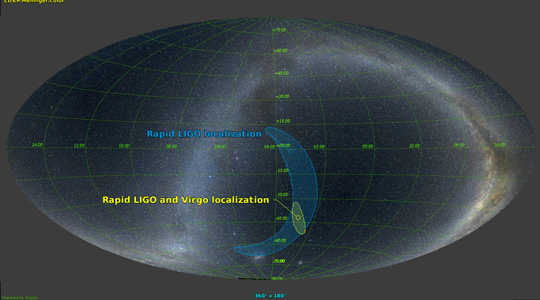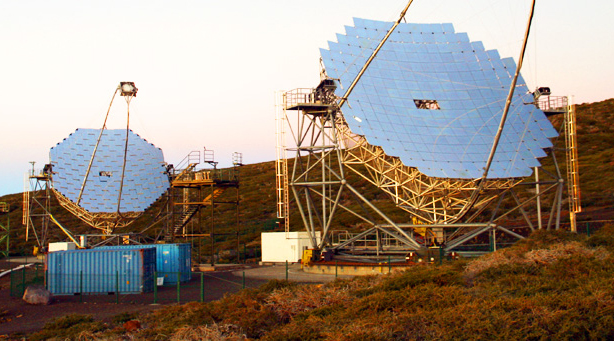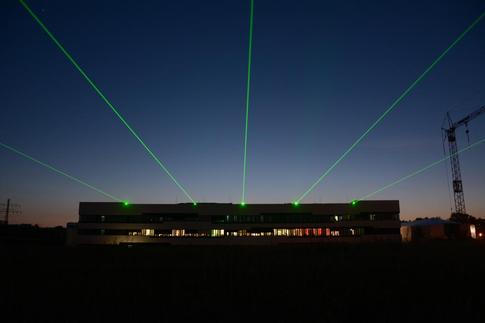LIGO-VIRGO: A NEW ERA FOR GRAVITATIONAL WAVE SCIENCE
 The Virgo collaboration and the LIGO Scientific Collaboration reported on September the 27th, during the G7 Science and Technology Summit in Torino, the first three-detector observation of gravitational waves. This result highlights the scientific potential of a global network of gravitational wave detectors, by delivering a better localization of the source and access to polarizations of gravitational waves.
The two Laser Interferometer Gravitational-Wave Observatory (LIGO) detectors, located in Livingston, Louisiana, and Hanford, Washington, USA and the Virgo detector, located at the European Gravitational Observatory (EGO) in Cascina, near Pisa, Italy, detected a transient gravitational-wave signal produced by the coalescence of two stellar mass black holes.
The three-detector observation was made on August 14, 2017 at 10:30:43 UTC. The detected gravitational waves – ripples in space and time – were emitted during the final moments of the merger of two black holes with masses about 31 and 25 times the mass of the Sun and located about 1.8 billion light-years away. The newly produced spinning black hole has about 53 times the mass of our Sun. This means that about 3 solar masses were converted into gravitational-wave energy during the coalescence.
This is the fourth detection of a binary black hole system. While this new event is of astrophysical relevance, its detection comes with an additional asset: this is the first significant gravitational wave signal recorded by the Virgo detector, which has recently completed its upgrade to Advanced Virgo.
The Virgo collaboration and the LIGO Scientific Collaboration reported on September the 27th, during the G7 Science and Technology Summit in Torino, the first three-detector observation of gravitational waves. This result highlights the scientific potential of a global network of gravitational wave detectors, by delivering a better localization of the source and access to polarizations of gravitational waves.
The two Laser Interferometer Gravitational-Wave Observatory (LIGO) detectors, located in Livingston, Louisiana, and Hanford, Washington, USA and the Virgo detector, located at the European Gravitational Observatory (EGO) in Cascina, near Pisa, Italy, detected a transient gravitational-wave signal produced by the coalescence of two stellar mass black holes.
The three-detector observation was made on August 14, 2017 at 10:30:43 UTC. The detected gravitational waves – ripples in space and time – were emitted during the final moments of the merger of two black holes with masses about 31 and 25 times the mass of the Sun and located about 1.8 billion light-years away. The newly produced spinning black hole has about 53 times the mass of our Sun. This means that about 3 solar masses were converted into gravitational-wave energy during the coalescence.
This is the fourth detection of a binary black hole system. While this new event is of astrophysical relevance, its detection comes with an additional asset: this is the first significant gravitational wave signal recorded by the Virgo detector, which has recently completed its upgrade to Advanced Virgo.




 A result published in September in Science by the Pierre Auger Observatory situated in Argentina, in Mendoza Province, answers questions that scientists have been asking for half a century. Where do high energy cosmic rays come from? Are they produced in our galaxy or do they come from distant galaxies? Auger's recent results clearly indicate an extragalactic origin of these particles, an important first step that will be followed by many others in order to identify the sources that emitted them. Cosmic Rays are high energy atomic particles and nuclei that, moving almost at the speed of light, hit the Earth from every direction and possess different energies. The experiment obtained this important result by observing very high energy cosmic particles (of the order of tens of exaelectron volts). At these energies, cosmic rays do not arrive uniformly from all directions in the sky. In fact, the frequency with which they arrive shows an excess in an area located about 120° from the centre of our galaxy, from a direction distant, therefore, from the galactic centre. The Pierre Auger Observatory is the largest cosmic ray observatory ever built by man, an international collaboration with over 400 scientists from 18 countries. Situated in the heart of the Argentine Pampas, it is named after the French physicist Pierre Auger, the discoverer of cosmic rays. The observatory is a hybrid system that includes surface detectors and fluorescence telescopes situated in proximity to the Andes Mountains at a height of 1400 metres. The surface detectors (approx. 1600) cover an area of 3000 sq. km, spaced 1.5 km apart, and are able to observe swarms of cosmic rays when they hit the Earth's surface. The fluorescence telescopes (27 in total), on the other hand, observe the weak light produced by the swarms while they form in the atmosphere (Cherenkov radiation). The joint activity of the two detection systems allows the energy and direction of the cosmic rays to be identified and the fundamental information on the location and type of sources to be traced. INFN has contributed to the implementation of the Pierre Auger Observatory and is actively participating in its upgrade program. About 15% of the scientists of the Auger collaboration are Italian and their participation in the research activities of the Observatory is possible thanks to the contribution of the Italian Institute for Nuclear Physics, the Italian Institute for Astrophysics and the Universities of L'Aquila, Catania, Milan, Federico II of Naples, Rome Tor Vergata, Salento and Turin, of the Politecnico of Milan and of GSSI. Auger is part of a global multi-messenger astronomy program that sees INFN engaged in the Fermi, Magic, CTA, KM3NET, Padme and Virgo experiments. With the development of new detectors and experimental methods, multi-messenger astronomy, engaged in the coordinated detection of electromagnetic signals, cosmic rays, gamma rays, high energy neutrons and gravitational waves – recently detected for the first time by the LIGO and Virgo collaborations – will allow us to observe the universe in its variety, integrating the results obtained in particle physics, theoretical physics and astronomy in as unitary a framework as possible.
A result published in September in Science by the Pierre Auger Observatory situated in Argentina, in Mendoza Province, answers questions that scientists have been asking for half a century. Where do high energy cosmic rays come from? Are they produced in our galaxy or do they come from distant galaxies? Auger's recent results clearly indicate an extragalactic origin of these particles, an important first step that will be followed by many others in order to identify the sources that emitted them. Cosmic Rays are high energy atomic particles and nuclei that, moving almost at the speed of light, hit the Earth from every direction and possess different energies. The experiment obtained this important result by observing very high energy cosmic particles (of the order of tens of exaelectron volts). At these energies, cosmic rays do not arrive uniformly from all directions in the sky. In fact, the frequency with which they arrive shows an excess in an area located about 120° from the centre of our galaxy, from a direction distant, therefore, from the galactic centre. The Pierre Auger Observatory is the largest cosmic ray observatory ever built by man, an international collaboration with over 400 scientists from 18 countries. Situated in the heart of the Argentine Pampas, it is named after the French physicist Pierre Auger, the discoverer of cosmic rays. The observatory is a hybrid system that includes surface detectors and fluorescence telescopes situated in proximity to the Andes Mountains at a height of 1400 metres. The surface detectors (approx. 1600) cover an area of 3000 sq. km, spaced 1.5 km apart, and are able to observe swarms of cosmic rays when they hit the Earth's surface. The fluorescence telescopes (27 in total), on the other hand, observe the weak light produced by the swarms while they form in the atmosphere (Cherenkov radiation). The joint activity of the two detection systems allows the energy and direction of the cosmic rays to be identified and the fundamental information on the location and type of sources to be traced. INFN has contributed to the implementation of the Pierre Auger Observatory and is actively participating in its upgrade program. About 15% of the scientists of the Auger collaboration are Italian and their participation in the research activities of the Observatory is possible thanks to the contribution of the Italian Institute for Nuclear Physics, the Italian Institute for Astrophysics and the Universities of L'Aquila, Catania, Milan, Federico II of Naples, Rome Tor Vergata, Salento and Turin, of the Politecnico of Milan and of GSSI. Auger is part of a global multi-messenger astronomy program that sees INFN engaged in the Fermi, Magic, CTA, KM3NET, Padme and Virgo experiments. With the development of new detectors and experimental methods, multi-messenger astronomy, engaged in the coordinated detection of electromagnetic signals, cosmic rays, gamma rays, high energy neutrons and gravitational waves – recently detected for the first time by the LIGO and Virgo collaborations – will allow us to observe the universe in its variety, integrating the results obtained in particle physics, theoretical physics and astronomy in as unitary a framework as possible. For ten years, in the bowels of the Gran Sasso mountain, the Borexino experiment has been scanning the sky above us and the heart of our planet, installed at the INFN Gran Sasso National Laboratories (LNGS). The tenth anniversary of Borexino's full operation and of the collection of scientific data was celebrated at LNGS and at the Gran Sasso Science Institute (GSSI) with an event that attracted the most important physicists and astrophysics in the world, including Art McDonald, Nobel Prize winner in Physics in 2015 for his neutrino studies, Yoichiro Suzuki, Head of Super-Kamiokande, one of the world's most important neutrino experiments, Victor Matveev, Director of the JINR in Dubna, the most important Russian physics research centre, Masayuki Nakahata, one of the authors of the measurement of the latest supernova explosion detected on Earth, Alexei Smirnov, author of the MSW effect explaining neutrino oscillation, Laura Cadonati, Deputy Head of the LIGO collaboration who, along with the colleagues from the Virgo collaboration, made the historic discovery of gravitational waves, Jim Cao, Vice President of IHEP, the Chinese high energy physics institute, and many others. Their host was Gianpaolo Bellini, creator of Borexino and its coordinator for 22 years, while opening the proceedings were Fernando Ferroni, President of INFN and Stefano Ragazzi, Director of LNGS. With important results ranging from the measurement of the properties of solar neutrinos in a wide energy spectrum, of the Sun's energy at the time of its generation, to the detection of geoneutrinos and to the first observation in a vacuum of the neutrino oscillation phenomenon, Borexino has had and still has significant resonance in all major international conferences, giving fundamental contributions to our advances in physics, astrophysics and geophysics. These results were made possible thanks to the technological success of Borexino, which holds the world record for the "most radio-pure" experiment in its sector. The experiment, the result of a collaboration between European countries (Italy, Germany, France, Poland), the United States and Russia, will continue its data acquisition for a few more years, improving the accuracy of the measurements already taken as well as addressing new ones.
For ten years, in the bowels of the Gran Sasso mountain, the Borexino experiment has been scanning the sky above us and the heart of our planet, installed at the INFN Gran Sasso National Laboratories (LNGS). The tenth anniversary of Borexino's full operation and of the collection of scientific data was celebrated at LNGS and at the Gran Sasso Science Institute (GSSI) with an event that attracted the most important physicists and astrophysics in the world, including Art McDonald, Nobel Prize winner in Physics in 2015 for his neutrino studies, Yoichiro Suzuki, Head of Super-Kamiokande, one of the world's most important neutrino experiments, Victor Matveev, Director of the JINR in Dubna, the most important Russian physics research centre, Masayuki Nakahata, one of the authors of the measurement of the latest supernova explosion detected on Earth, Alexei Smirnov, author of the MSW effect explaining neutrino oscillation, Laura Cadonati, Deputy Head of the LIGO collaboration who, along with the colleagues from the Virgo collaboration, made the historic discovery of gravitational waves, Jim Cao, Vice President of IHEP, the Chinese high energy physics institute, and many others. Their host was Gianpaolo Bellini, creator of Borexino and its coordinator for 22 years, while opening the proceedings were Fernando Ferroni, President of INFN and Stefano Ragazzi, Director of LNGS. With important results ranging from the measurement of the properties of solar neutrinos in a wide energy spectrum, of the Sun's energy at the time of its generation, to the detection of geoneutrinos and to the first observation in a vacuum of the neutrino oscillation phenomenon, Borexino has had and still has significant resonance in all major international conferences, giving fundamental contributions to our advances in physics, astrophysics and geophysics. These results were made possible thanks to the technological success of Borexino, which holds the world record for the "most radio-pure" experiment in its sector. The experiment, the result of a collaboration between European countries (Italy, Germany, France, Poland), the United States and Russia, will continue its data acquisition for a few more years, improving the accuracy of the measurements already taken as well as addressing new ones.
 On 1 September in Hamburg, the European XFEL, the European super microscope implemented also thanks to the Italian contribution with INFN, was inaugurated. This is a free electron laser that will allow the structure of macromolecules in action to be observed. Unlike traditional techniques for determining the structure of a macromolecule through X-rays, the European XFEL can also analyse non-crystallised macromolecules. This is a significant advantage since, in addition to allowing macromolecular structures that are difficult to crystallise to be observed, it allows photographs of macromolecules at different moments in their lives to be taken. And collecting many different photos of the same molecule, one can obtain a video of the motion of the macromolecule in activity, be it an enzyme, a virus or a catalyst. The laser is 2.1 km long. It generates X-rays by accelerating free electrons along a 1.7 km tunnel and curving the path of these electrons through a series of magnets. The radiation emitted is very intense, the affected specimens emit many photons that allow the atomic structure of the macromolecule analysed to be identified. The radiation is so intense that the specimens are then destroyed. INFN has made a fundamental contribution to the implementation of the electron accelerator by developing some of the key elements at LASA laboratory in Milan, such as the photoemissive source of cold and intense electrons, the superconductive acceleration modules and the third harmonic system for the linearisation of the beam. The European XFEL had a total cost of 1.2 billion euros and Italy contributed to the project with a funding of approx. 40 million euros, allocated by MIUR and mediated by INFN. The first experiments of the European free electron laser will start in September 2017.
On 1 September in Hamburg, the European XFEL, the European super microscope implemented also thanks to the Italian contribution with INFN, was inaugurated. This is a free electron laser that will allow the structure of macromolecules in action to be observed. Unlike traditional techniques for determining the structure of a macromolecule through X-rays, the European XFEL can also analyse non-crystallised macromolecules. This is a significant advantage since, in addition to allowing macromolecular structures that are difficult to crystallise to be observed, it allows photographs of macromolecules at different moments in their lives to be taken. And collecting many different photos of the same molecule, one can obtain a video of the motion of the macromolecule in activity, be it an enzyme, a virus or a catalyst. The laser is 2.1 km long. It generates X-rays by accelerating free electrons along a 1.7 km tunnel and curving the path of these electrons through a series of magnets. The radiation emitted is very intense, the affected specimens emit many photons that allow the atomic structure of the macromolecule analysed to be identified. The radiation is so intense that the specimens are then destroyed. INFN has made a fundamental contribution to the implementation of the electron accelerator by developing some of the key elements at LASA laboratory in Milan, such as the photoemissive source of cold and intense electrons, the superconductive acceleration modules and the third harmonic system for the linearisation of the beam. The European XFEL had a total cost of 1.2 billion euros and Italy contributed to the project with a funding of approx. 40 million euros, allocated by MIUR and mediated by INFN. The first experiments of the European free electron laser will start in September 2017.

